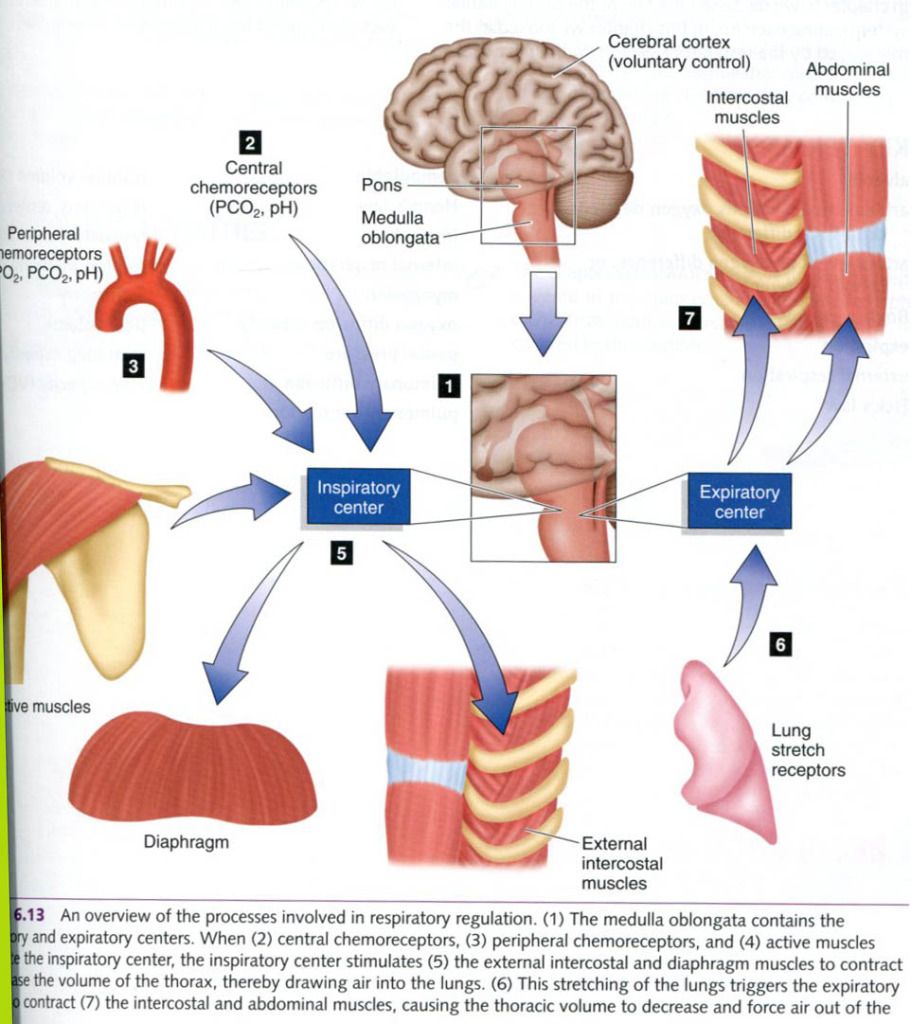Mechanisms of regulation
The respiratory muscles are under the direct
control of motor neurons, which are in turn regulated by respiratory
centers(inspiratory and expiratory) located within the brain stem(in the
medulla oblongata and pons). These centers establish the rate and depth of
breathing by sending out periodic impulses to the respiratory muscles. The cortex can override these centers if
voluntary control of respiration is desired. Additionally, input from other
parts of the brain occurs under certain conditions.
The inspiratory
area of the brain(dorsal respiratory group) contains cells that
intrinsically fire and control the basic rhythm of ventilation. The expiratory area is quiet during normal
quiet breathing(recall that expiration is a passive process at rest). However,
during forceful breathing such as during exercise, the expiratory area actively
sends signals to the muscles of expiration. Two other brain centers aid in the
control of respiration. The apneustic area has an excitatory effect on the
inspiratory center and results in prolonged firing of the inspiratory neurons.
Finally, the pneumotaxic center inhibits or “switches off” inspiration, helping
to regulate inspiratory volume.
The respiratory centers do not act alone in
controlling breathing. Breathing also is regulated and modified by the changing
chemical environment in the body. For example, sensitive areas in the brain
respond to changes in carbon dioxide and H+ levels. The central
chemoreceptors in the brain are stimulated by an increase in H+ ions
in the cerebrospinal fluid. The blood-brain barrier is relatively impermeable
to H+ ions or bicarbonate. However, CO2 readily diffuses
across the blood-brain barrier and then reacts to increase H+ ions.
This, in turn, stimulates the inspiratory center, which then activates the
neural circuitry to increase the rate and depth of respiration. This increase
in respiration, in turn, increases the removal of carbon dioxide and H+.
Chemoreceptors in the aortic arch(the aortic
bodies) and in the bifurcation of the common carotid artery(the carotid bodies)
are sensitive primarily to blood changes in PO2 but also respond to
changes in H+ concentration and PCO2. The carotid
chemoreceptors are more sensitive to changes in H+ concentration and
PCO2. Overall, PCO2 appears to be the strongest stimulus
for the regulation of breathing. When carbon dioxide levels become too high,
carbonic acid forms, then quickly dissociates, giving off H+. If H+
accumulates, the blood becomes too acidic(pH decreases). Thus, an increased PCO2
stimulates the inspiratory center to increase respiration – not to bring in
more oxygen but to rid the body of excess carbon dioxide and limit further pH
changes.
In addition to the chemoreceptors, other neural
mechanisms influence breathing. The pleurae, bronchioles, and alveoli in the
lungs contain stretch receptors. When these areas are excessively stretched,
that information is relayed to the expiratory center. The expiratory center
responds by shortening the duration of an inspiration, which decreases the risk
of overinflating the respiratory structures. This response is known as the
Hering-Breuer reflex.
Many control mechanisms are involved in the
regulation of breathing, as shown in the figure below. Such simple stimuli as
emotional distress or an abrupt change in the temperature of the surroundings
can affect breathing. But all these control mechanisms are essential. The goal
of respiration is to maintain appropriate levels of the blood and tissue gases
and to maintain proper pH for normal cellular function. Small changes in any of
these, if not carefully controlled, could impair physical activity and
jeopardize health.










1 коментара:
I really appreciate DR AKHIGBE,my name is LAURIE HUGHES . I will never stop testifying DR AKHIGBE , Happiness is all i see now I never thought that I will be cured from HIV virus again. DR AKHIGBE did it for me I have been suffering from a deadly disease (HIV) for the past 2 years now, I had spent a lot of money going from one place to another, from churches to churches, hospitals have been my home every day residence. Constant checks up have been my hobby not until this faithful day, I saw a testimony on how DR AKHIGBE helped someone in curing his HIV disease in internet quickly I copied his email which is drrealakhigbe@gmail.com just to give him a test I spoke to him, he asked me to do some certain things which I did, he told me that he is going to provide the herbal cure to me, which he did, then he asked me to go for medical checkup after some days, after using the herbal cure and i did, behold I was free from the deadly disease,till now no HIV in me again he only asked me to post the testimony through the whole world, faithfully am doing it now,all the testimony of DR AKHIGBE is true please BROTHER and SISTER, MOTHER and FATHER he is great, I owe him in return. if you are having a similar problem just email him on drrealakhigbe@gmail.com or you can whats App his mobile number on +2349010754824 He can also cure these diseases like HIV and AIDS, DENGUE FEVER. HERPES,DIABETICS,CANCER, HEPATITIS A&B,CHRONIC DISEASES, HIGH BLOOD PRESURE, OBESITY, ASTHMA, HEART DISEASES, EXTERNAL INFECTION, EPILEPSY, STROKE, MULTIPLE SCLEROSIS, NAUSEA,VOMITING OR DIARRHEA LUPUS,ECZEMA,BACK PAIN,JOINT PAIN, ERYSIPELAS, MALARIA, BACTERIA , PULMONARY FIBROSIS. DIARRHEA,JAPANISE B ENCEPHALITIES, RABIE, BREAST INFECTION. CYSTIC FIBROSIS, ETC .please email drrealakhigbe@gmail.com or whats APP him ..+2349010754824 he is a real good and honest man. website... https:drrealakhigbe.weebly.com
Постави коментар